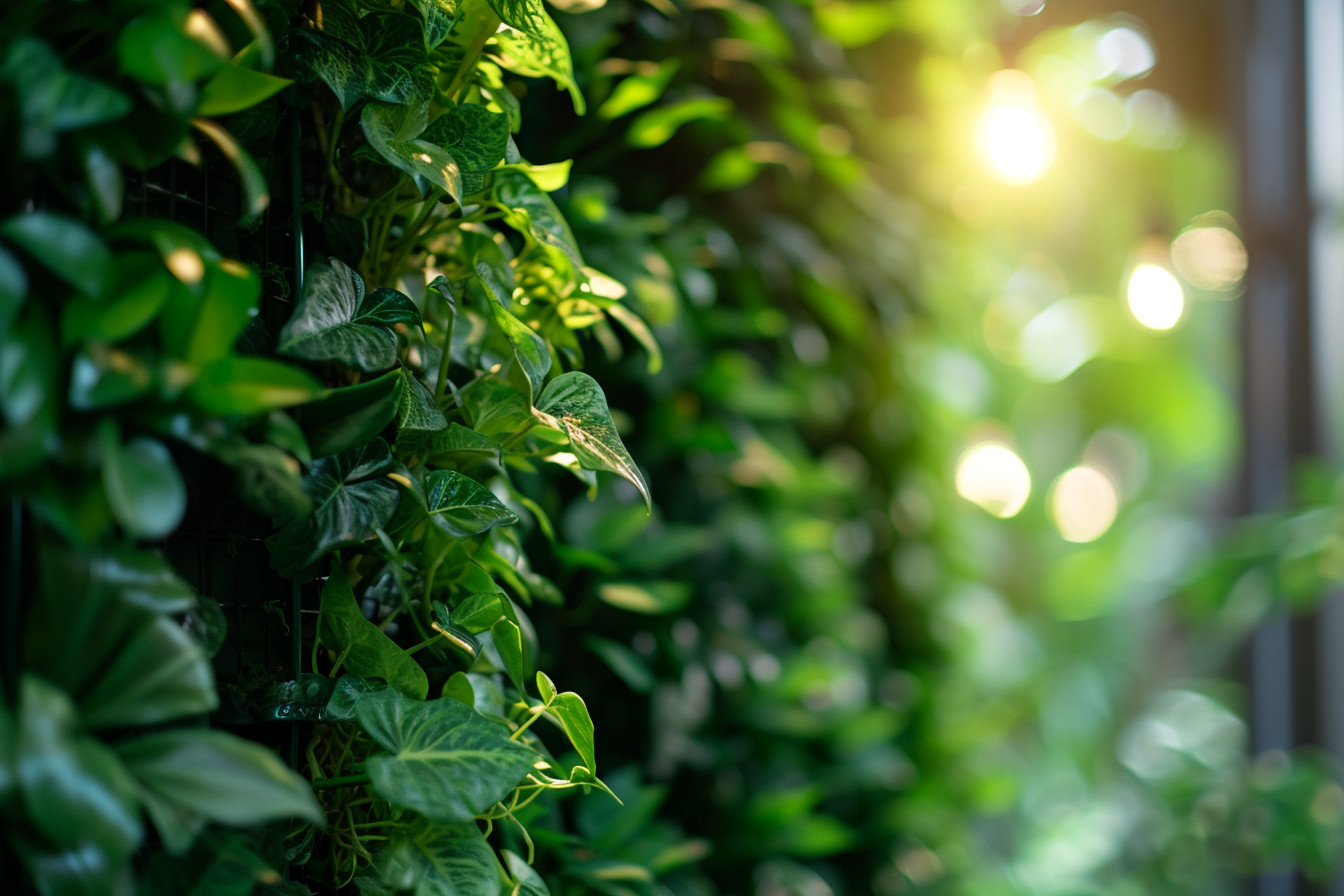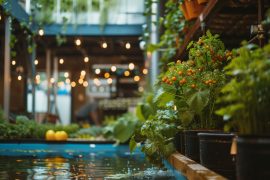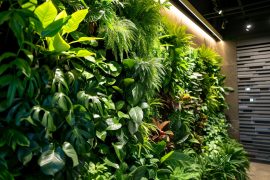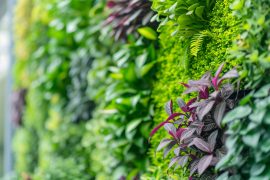I’ve always believed that gardens should be more than just a splash of green; they should stir the soul and offer a tranquil escape. That’s why I’m all about vertical gardens—they transform any bland wall into a lush tapestry of foliage and flowers. It’s like hanging a living piece of art!
Benefits of Vertical Gardens
When I think about the serene tranquility of a garden, I can’t help but feel that vertical gardens amplify this effect. They’re not just space savers; they’re legitimate game-changers in urban landscapes and indoor settings. Drawing from my own slice of paradise hanging on the wall, I’ve come to appreciate the myriad benefits these gardens offer.
Elevated Beauty in Compact Spaces: It’s a no-brainer that in bustling cities, space is at a premium. That’s where vertical gardens come in as a stroke of genius. They offer an ingenious solution, allowing lush greenery to thrive skywards. The way they beautify a space isn’t just pleasing to the eye, it’s transformative. They turn monotonous walls into vibrant canvases, turning every glimpse into an encounter with nature.
Air Quality Ace: Another notch on the belt for vertical gardens is their knack for purifying the air. Cities can feel like they’re choking on their own breath, but introduce a wall of plants, and you’ve got yourself a natural air filter. I’ve personally felt the difference in my home; there’s something about knowing that each breath is sifted through leaves that eases the mind.
Noise Reduction: Then there’s the hush that falls with a living wall. Plants are natural sound absorbers, making vertical gardens perfect for dampening city din. It’s like having an insulated barrier, only greener and prettier. I often find myself retreating to my vertical oasis to escape the clamor of the outside world.
- Space-saving and beautifying
- Natural air purification
- Effective sound insulation
Reduced Energy Consumption: Now, let’s talk energy. By acting as additional insulation, these green walls can keep buildings warmer in winter and cooler in summer. It’s not just about what they give; it’s also about what they save. My energy bills have felt the impact, and anything that’s good for the wallet and the planet is a win in my book.
Therapeutic Touch: Gardening is inherently therapeutic, but when it comes to vertical gardening, you’re not bending over backward, literally. The physical strain is less, yet the emotional rewards are just as potent. There’s a profound sense of satisfaction in nurturing something that in turn nurtures you, all without the aches and pains usually associated with gardening.
Choosing the Right Plants for Your Vertical Garden
When I’m planning a new vertical garden, the first thing I think about is the plants I want to use. Not every plant is suited for this kind of set up, so I’ve got to be choosy to make sure my garden’s not only beautiful but also thriving.
Sunlight is a huge factor when selecting plants. I always consider the direction my wall faces. Is it getting lots of direct sunlight or is it more in the shade? For sun-loving plants, I’ll go for succulents or flowering perennials like petunias. If it’s a shaded area, I’ll pick ferns or ivy, which can flourish without much direct light.
Next up – let’s talk about water needs. It’s common sense, right; plants at the top of a vertical garden will “drink” first, so they should be the ones that can handle drier conditions. I plant those that need more water at the bottom. It’s a great way to ensure everyone’s happy and hydrated.
But here’s something I’ve learned: it’s not enough to only think about the practicality – the aesthetics are super important too. I look for a variety of textures, colors, and sizes to give my garden depth and make it visually appealing. Picture this: vibrant green of sedum mixed with the deep red of a Heuchera – it’s like painting with plants!
I often use natives because they’re used to the local climate and tend to be less finicky. They’re like the old friends who never let you down. Here’s a pro tip: pollinator-friendly plants can add life to your garden bringing in butterflies and bees which is the kind of buzz I want around my serene green space.
Now for a little bit of storytelling. Once, when designing a vertical garden for a community center, I chose plants that were not only beautiful but also edible. The garden became a living salad wall! Herbs like basil and parsley paired with lettuce varieties – it was a feast for the senses and encouraged the community to engage with the garden in a very tangible, delicious way.
Design Considerations for Vertical Gardens
When it comes to putting together a vertical garden, it’s like working on a living painting. Each choice I make can impact the overall vibe of the space. I’ve found it’s not just about tossing some plants up and calling it a day. Nope, there’s much more to it.
First, light exposure is critical. Depending on which direction your wall faces will determine which plants will thrive. North-facing walls might enjoy less direct sunlight, which is perfect for ferns and other shade-loving plants. Meanwhile, a south-facing wall can handle succulents or other sun-seekers. If you’re like me, I often find myself playing with light patterns to create just the right environment for each plant.
Then there’s the watering system. Vertical gardens need a solid game plan for hydration. Automatic drip systems save time and keep my plants happy. Plus, I never have to stretch with a watering can to reach that top row again!
Support structures are non-negotiable. You’ll need a strong framework to hold your plants in place. I go for materials that are not only sturdy but also blend well with the garden design. Sometimes I use metal grids, other times recycled wooden pallets — it all depends on the look and feel I’m going for.
Mixing and matching plant types can create a stunning array of colors and textures, but it’s essential not to overcrowd. I space my plants out so they have room to grow and avoid the battle for resources. Plus, it’s easier to manage any pests or diseases that might pop up.
Here are some plants I’ve used successfully in vertical gardens:
- Sedums: Low maintenance and come in cool shapes and colors.
- Ferns: Perfect for shadier spots and add a lush green backdrop.
- Herbs: Makes the garden both pretty and practical. I love picking fresh basil right off my wall!
Beyond the plants, I focus on aesthetic harmony. The materials, the style of planters, and the types of plants all need to speak the same design language. It’s not just about what I like individually but how the elements work together to create something beautiful.
Vertical Garden Installation and Maintenance
When I first dipped my toes into the world of vertical gardens, I was drawn in by their stunning appearance and environmental benefits. What I quickly learned was that installation and maintenance are just as crucial as the design phase.
Setting up a vertical garden begins with a solid plan. You’ve got to consider how the weight of the plants and their supports will affect your wall. Structurally sound walls are essential, and sometimes you may need to reinforce them before starting. I always recommend consulting a professional if you’re unsure. The last thing you want is for your living art to turn into a safety hazard.
Selecting the right growing medium is next. Soil-based systems are great but can be heavy and require more structure. Hydroponic systems, which use a nutrient-rich water solution, are lighter and can be fantastic for indoor settings. Regardless of the type, ensure that it’s suited for your chosen plants and climate conditions.
Here’s a rundown of key installation points:
- Secure your installation surface.
- Choose between soil or hydroponic medium.
- Install a reliable irrigation system.
- Position plants to avoid overcrowding.
- Incorporate support structures as needed.
Maintaining your vertical garden is where the real fun begins. Regular checks and balances keep your garden thriving. I’ve got a watering schedule pinned right next to my garden, so I don’t miss it. Watering systems can range from manual to fully automated – sophistication depends on your time and budget. Just remember that each plant has unique needs, so customization is key.
Pruning and feeding your plants shouldn’t be overlooked. Pruning not only keeps your vertical garden looking tidy but also encourages new growth and prevents disease. As for feeding, I use a balanced liquid fertilizer every other week to complement my plants’ diet.
Pest and disease management is, unfortunately, part of the gig too. I conduct weekly inspections for any signs of trouble. Catching issues early, like an unwanted aphid guest, can save you a lot of headache later on. Natural pesticides and regular maintenance routines typically keep most problems at bay.
- Lack of nutrients: Yellowing leaves are a telltale sign. A little extra fertilizer can often fix this.
- Overwatering: If leaves look wilted or brown, ease up on the water and let the roots breathe.
- Inade
Examples of Stunning Vertical Gardens
I’ve had the chance to visit some breathtaking vertical gardens around the world, and let me tell you, they’re nothing short of remarkable. In the heart of Singapore, Gardens by the Bay stands out with its Supertree Grove—massive vertical gardens that double as solar cells and air venting ducts. During my visit, I was in awe of the seamless integration of technology and nature. The sight of these towering vertical gardens, especially at night when they’re all lit up, is simply mesmerizing.
Then there’s the CaixaForum in Madrid, a cultural center that boasts a lush vertical garden covering its outer wall. It’s like an enchanting tapestry woven with plant life, and it left me marveling at the artistic expression conveyed through flora. Walking past it, I couldn’t help but feel a sense of peace, as if the hustle of the city had been momentarily hushed by this green masterpiece.
Closer to home, I dropped by The Drew School in San Francisco, where the vertical garden brings a slice of nature right into the urban jungle. It’s incredible how this living wall serves as a sanctuary for both students and local wildlife. Birds and butterflies are as much a part of this garden as the native plants that climb the school’s wall. What sticks with me is the soft buzz of city life paired with the tranquil rustling of leaves—an unexpected duet.
- Some features these gardens have in common include:
- A diverse array of plant species
- Integrated irrigation systems
- Thoughtful placement to maximize visual impact and environmental benefits
Designing vertical gardens like these isn’t just about aesthetics though. It’s about creating ecosystems and promoting biodiversity in urban spaces. By doing so, I’ve noticed that we not only enhance the beauty of our surroundings but also contribute positively to our mental well-being and the urban climate.
I’d like to dive into the technical aspect a little here. These gardens don’t just magically thrive; they’re a result of careful planning and a solid understanding of the local climate and plant requirements. For example, the vertical garden at Patrick Blanc’s Quai Branly Museum in Paris uses a felt-based hydroponic system that supports diverse plant life without using soil.
| Location | System Used | Unique Feature |
|---|---|---|
| Gardens by the Bay, Singapore | Solar cells, |
Final Thought
I’ve taken you through the lush, gravity-defying world of vertical gardens, from the towering Supertree Grove to the intricate ecosystems nestled in urban landscapes. It’s clear that with the right blend of creativity and horticultural savvy, these living tapestries are more than just eye candy—they’re a testament to how we can reimagine our relationship with nature. Remember, whether you’re inspired by the hydroponic marvels in Paris or planning your own slice of vertical paradise, it’s all about respecting the plants and the environment they’ll call home. So go ahead, let your imagination climb up those walls and maybe, just maybe, you’ll create something truly breathtaking.








